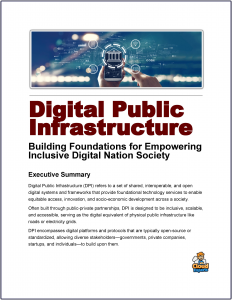Artificial Intelligence – The Next Frontier In Digital Public Infrastructure
By integrating AI, DPI systems become more efficient, accessible, and inclusive, transforming how public services are delivered.
 AI is reshaping Digital Public Infrastructure (DPI), which encompasses shared digital systems like identity, payment, and data exchange platforms that enable seamless service delivery for governments, businesses, and citizens.
AI is reshaping Digital Public Infrastructure (DPI), which encompasses shared digital systems like identity, payment, and data exchange platforms that enable seamless service delivery for governments, businesses, and citizens.
By integrating AI, DPI systems become more efficient, accessible, and inclusive, transforming how public services are delivered.
AI personalizes citizen interactions by powering tools like chatbots and virtual assistants, such as those in India’s UMANG app, which guide users through government services in multiple languages.
Foundation for Digital Services Automation
It also automates processes like document verification and grievance redressal, streamlining operations in systems like Aadhaar, India’s digital identity platform. Furthermore, AI-driven analytics identify underserved populations, helping extend DPI services to remote or marginalized communities, ensuring broader access to platforms like India’s Unified Payments Interface (UPI).
In digital identity systems, AI plays a pivotal role by enhancing security and accuracy. Advanced algorithms improve biometric authentication, such as facial recognition and iris scanning, making platforms like Aadhaar or Nigeria’s NIMC reliable for millions.
AI also detects fraud by identifying anomalies in identity usage, preventing misuse in welfare programs or financial transactions. To protect citizen privacy, techniques like federated learning and differential privacy are employed, ensuring compliance with regulations like GDPR or India’s DPDP Act. These capabilities make AI indispensable for secure and scalable digital identity frameworks within DPI.
AI also drives financial inclusion through digital payment systems. In platforms like UPI or Kenya’s M-Pesa, AI enables real-time fraud detection and risk assessment, ensuring secure transactions.
Data Analysis
By analyzing alternative data, such as transaction histories or mobile usage, AI facilitates credit scoring for unbanked populations, unlocking access to microloans and insurance. Additionally, AI-powered chatbots educate users on financial tools, boosting adoption in regions with low financial literacy. These advancements make DPI a powerful tool for economic empowerment.
Beyond identity and payments, AI enhances data exchange and interoperability within DPI. It processes vast datasets to generate insights for policy-making, such as optimizing resource allocation for health or education.
AI ensures seamless integration across DPI components by resolving data inconsistencies and predicting system bottlenecks. It also supports predictive maintenance, monitoring infrastructure to prevent outages or cyberattacks, thus maintaining system reliability. These capabilities enable governments to make data-driven decisions and ensure robust DPI ecosystems.
AI promotes inclusivity by making DPI accessible to diverse populations. Natural language processing enables multilingual support, as seen in India’s Bhashini platform, which provides real-time translation for government services. AI tools like text-to-speech and image recognition enhance usability for people with disabilities, while bias mitigation algorithms work to ensure equitable service delivery across gender, race, or socioeconomic lines.
Conclusion
However, challenges remain, including the risk of algorithmic bias, data privacy concerns, and the digital divide, which could exclude those without internet or device access. Strong governance frameworks, like India’s National AI Strategy, are essential to address these issues transparently and accountably.
Globally, AI’s impact on DPI is evident in systems like India’s India Stack, which uses AI for fraud detection and service personalization, Estonia’s e-Governance platform, which automates tax filings and secures citizen services, and Singapore’s Smart Nation initiatives, which leverage AI for urban planning.
Looking ahead, AI’s potential in DPI is vast, from enabling predictive governance to supporting decentralized systems with blockchain or creating dynamic, citizen-centric interfaces with generative AI. While AI is a cornerstone of modern DPI, careful governance is critical to balance innovation with ethical and privacy considerations.




